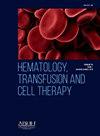PLEURAL EFFUSION DEVELOPING AS A CONSEQUENCE OF G-CSF ADMINISTRATION IN A PATIENT UNDERGOING AML TREATMENT
IF 1.8
Q3 HEMATOLOGY
引用次数: 0
Abstract
Objective
Human granulocyte colony-stimulating factor (G-CSF) plays a vital role in boosting neutrophil production from hematopoietic progenitor cells, both in lab settings and within the human body. Beyond just raising neutrophil counts, G-CSF primes these cells, enhancing their ability to defend the body, making it a key player not only for neutropenic patients but also for those who are immunocompromised but not necessarily neutropenic. G-CSF is widely used in treating acute myeloid leukemia (AML), either alongside or following chemotherapy. One of its primary benefits is to speed up neutrophil recovery after chemotherapy, reducing both the length of hospital stays and the risk of infection.
Here, we share a case involving a 17-year-old male with AML who developed pleural effusion after receiving G-CSF during his cytotoxic treatment.
Case Report
The patient, a 17-year-old male, came to our clinic with an elevated white blood cell count and was subsequently diagnosed with acute myeloid leukemia (AML) after a bone marrow aspiration. He was immediately started on the 7+3 induction chemotherapy protocol. During the post-chemotherapy phase, when his neutrophil levels dropped, filgrastim (G-CSF) was introduced to help reduce the risk of infection and shorten the neutropenic period. For the first five days, everything seemed normal, and no side effects were noted. However, after that initial period, the patient began to experience worsening shortness of breath. Imaging revealed a growing pleural effusion on the left side. A diagnostic thoracentesis was performed, and the fluid was drained to provide relief. The analysis confirmed the fluid was transudative, with no signs of infection or malignancy. When the pleural effusion returned, G-CSF was promptly stopped, and the effusion rapidly resolved. After consolidation therapy, G-CSF was reintroduced, and once again, pleural effusion reappeared on the third day of treatment, but this too resolved spontaneously once the G-CSF was discontinued. A pleural biopsy showed no pathological findings, confirming that the G-CSF was likely responsible for the effusion.
Discussion
In neutropenic patients, pleural effusion is typically linked to infections, but in this case, no signs of infection or AML involvement were found. The recurring pleural effusion, which resolved after stopping G-CSF, suggests a rare side effect of the treatment. Research indicates that G-CSF may trigger local inflammatory responses, including elevated cytokines like IL-6 and TNF-α, potentially leading to fluid accumulation in the pleura. This case highlights the importance of monitoring for unusual side effects during G-CSF therapy in AML patients.
求助全文
约1分钟内获得全文
求助全文
来源期刊

Hematology, Transfusion and Cell Therapy
Multiple-
CiteScore
2.40
自引率
4.80%
发文量
1419
审稿时长
30 weeks
 求助内容:
求助内容: 应助结果提醒方式:
应助结果提醒方式:


